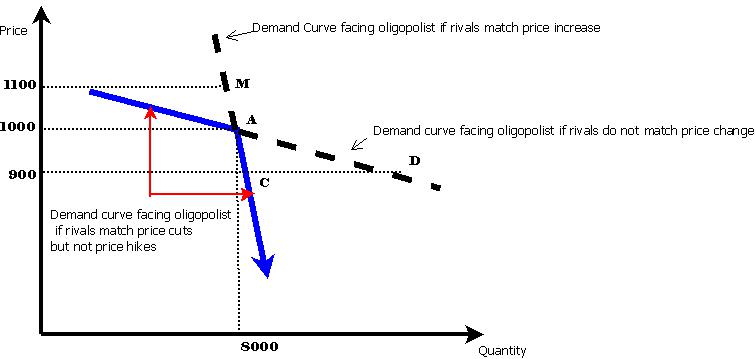Oligopoly
MICROECONOMICS

|
Oligopoly |

|
Introduction |
This is a market situation where there are more than 2 producers of a product.When there are two producers, it is called duopoly, which is also an imperfect market situation and so a special case of oligopoly. The number of producers in oligopoly are lesser than that of perfect competition and monopolistic competition. We will be studying the nature of this market and examining the features with case studies.You have already studied the other market structures like perfect competition and monopoly as well as monopolistic competition.Oligopoly is an actual market situation. When you do a study of the detailed features we can relate to the real life market structures.It is an imperfect market with few sellers of similar or differentiated products. The few firms in oligopoly enjoy a high degree of market power. The market power depends on the number of sellers, barriers to entry and availability of substitutes.Based on these criteria oligopoly enjoys substantial market power.in this market condition, a few firms dominate. When you think of soft drinks industry example, which names come to your mind? Pepsi, Coca-Cola . Tyre manufacturers- Dunlop, firestone, dominate. Other examples of oligopoly are mobile service providers, breakfast cereal makers.Take the case of electricity distribution in Mumbai. You must be aware that electricity distribution is in the hands of Tata Power and Reliance Energy.This means that these two big players have a lot of market power in deciding the price.
| Characteristics of Oligopoly |
1.Number of producers
There are very few producers in an oligopoly market. Foe example- Tyre manufacturers or the aviation industry.The market is shared among a few producers. The producers may sell homogeneous products or differentiated products. Example of homogeneous products - steel, coal, copper. Products may be differentiated as in the case of automobiles, soft drinks, mobile phone handsets. The producers of these products compete on the basis of differences in product like- different packaging,colour, flavour.
2.Huge Investments to Start Oligopoly Industries
Oligopoly markets are dominated by a few large producers and there are substantial barriers to the entry of new producers, though there is freedom of entry.The investments required to start oligopoly industries is very high. For instance there is scope for new entrants in the aviation industry in India. But it is not easy to survive in the face of stiff competition. The established companies discourage the new entrants in various ways. The existing firms may have a number of advantages like access to inputs or processes, cost advantage, exclusive dealerships and arrangements to get inputs at lower prices. Moreover,the new firms will take time to establish their brand in the market. The barriers may take the form of technology patents.Even the Governments may put up barriers such as limits to the number of licenses issued. In these ways entry for new producers become difficult.
3.Product Differentiation
The producers in an oligopoly market compete on the basis of product differentiation, which is a distinguishing feature of oligopoly.The products sold by the competing producers may be substitutes. However, one can easily recognize the product by its brand name, packaging and so on. Product differentiation helps to create a barrier for other potential producers to enter in industries like liquor, toothpaste etc.
4.Advertising
In oligopoly market situation, the producers are forced to advertise their product . Aggressive advertising measures are undertaken with a view to capture the market share. In fact, the producers compete on these lines rather than resorting to price cutting to attract buyers.Example- If Pepsi Foods sponsors a beauty pageant, Coca Cola will have to do something to attract more buyers.Aggressive advertising campaign may help a company to shift consumer preferences. The rival firms will be forced to adopt a similar strategy and they may adopt defensive advertising, as is clear from the example of Pepsi and Coke. According to William J.Baumol, advertising can become a life and death matter and the firms who fail to engage in advertising will lose its customers.
5. Group Behaviour and interdependence
Since the number of firms is few, the action of even one will have some effect on the other firms in the group. In oligopoly, the firms in a group may not be guided by a common goal. The group may or may not have a formal or informal organization bound by certain rules of conduct. The group may have a dominant leader, though the other firms may not follow him in all respects.
Example- Let us take the case o mobile handset industry as a hypothetical example. To start with let us assume that the market price of a handset is Rs. 1000 and 20,000 handsets are sold per month.The market share of three sellers Nokia, Samsung and L.G. is given below.
| Producer | Output | Market share |
| Nokia | 8000 | 40% |
| Samsung | 6500 | 32.5% |
| L.G. | 5500 | 27.5% |
All the companies wish to capture the market. The industry, with three players is making 20000x3000=6million sets. If Nokia tries to take away the customers from the others,their market share and profits will fall. Thus, any attempt by Nokia to increase sale will lead to a reaction from the other two rivals.They may strengthen their marketing efforts or cut the prices.
6. The oligopolist faces an indeterminate demand curve
There is a lot of interdependence among the oligopoly producers. The decisions of producers depend on the decisions and strategies followed by other competitors. This interdependence makes it makes it difficult to draw a definite demand curve like that of perfect competition and monopoly. For example, an oligopoly firm lowers the price of its product. It not sure how the competitors will react. They may reduce the price to the same extent or even lower to capture the market. Thus demand curve is indeterminate.
| Kinked Demand Curve |
The Kinked Demand Curve The demand curve under oligopoly is indeterminate. This is due to the interdependence of the oligopoly producers. Let us examine what happens if a producer under oligopoly reduces the price. In an oligopoly situation, an oligopolist can expect three kinds of reactions if the price is lowered
Responses to reduction in price
1. If the prices are cut by a producer, others may not react. This may lead to an increase in demand
2. When an oligopolist reduces price, others follow suit
3. When an oligopolist reduces the price, others may cut their prices even lower.
Now let us revert to the earlier example of Nokia having a market share of 40 %, selling 8000 handsets a month at a price of Rs.1000 each. Point A represents this output.
Suppose Nokia reduces its price to Rs. 900. This may increase the sales, depending on the response of the oligopolists. If nobody responds, the oligopolist can go to point D. What happens point D? At this point Nokia will be able to sell more hand sets. What will happen to the other companies, Samsung and L.G.? Their share is now taken away by Nokia. Will the others ignore this? Now the other producers Samsung and L.G. may cut the prices to Rs. 900 to maintain their sales. As a result, Nokia sales will increase slightly to Point C and not D. Thus, the increased sales due to price cut will have to be shared among all producers. Responses to Price increase Let us suppose that Nokia raises the price to Rs.1100. Others will not follow suit. Nokia’s sales will drop. Nokia’s sales will reduce from A to B at the increased price. So when anyone increases the price, others will not increase their prices. But if the prices are reduced it leads to similar reactions from rival forms. This brings out the fact that managing an oligopoly firm is not an easy task. Various factors have to be considered by a producer , when he goes ahead with the decisions to reduce price,spend money on advertising his product or taking investment decisions. The firms are involved in strategy making and they have to be alert to the actions of the other competing firms.
| The General Motors Versus FordThe General Motors introduced zero interest financing or price rebates in the sale of its automobiles. Ford, and other car manufacturers also followed suit and started offering attractive schemes to consolidate their position. Usually the oligopolists avoid price cutting methods to compete since it can lead to ruinous price wars and will mean losses for everyone. Therefore, advertising other sales promotional measures and product differentiation are the methods used to capture new markets . If G.M. Motors launches a major advertising campaign, Ford and Chrysler will surely be forced to react to this and do something to promote their products. |
Super market chains like Walmart, Spencers try to attract buyers from other stores by advertising or sometimes even by lowering the prices of certain selected food items. Though it looks like a price competition, it is not so. The super markets want to attract more buyers to the store and there will be a rang of products for which prices have not been reduced. The customers will make their purchases of these products also.But if the competing firms also cut their prices, the profit margins willr Fordeduce. However, the super markets end up better off as a result of such strategies,
The aviation industry in India used to be exclusively managed by Air India and Indian Airlines an the flying rates used top be high . With the entry of new private airlines like Jet, Kingfisher and Indigo into he aviation industry more competition was infused into the airline industry. They started offering various schemes like no frill flights, discount on advance booking, concessions for frequent fliers which attracted many people to opt for the services offered by these airlines. This made Air India also to offer similar types of concession and facilities to the customers. In this case , we see that the competition was based on both price wars to some extend and improved services in such way that flying became affordable to a ;larger section of people.

|
Activity |
| Write your activity here | |
| Example: {{{Example}}} |
|

|
Self-Assessment Questions (SAQs) {{{n}}} |
| {{{SAQ}}} | |
Solve the Quiz on Oligopoly

|
Results |

|
Key Terms |

|
References and Bibliography |

|
Further Readings |
</u>




